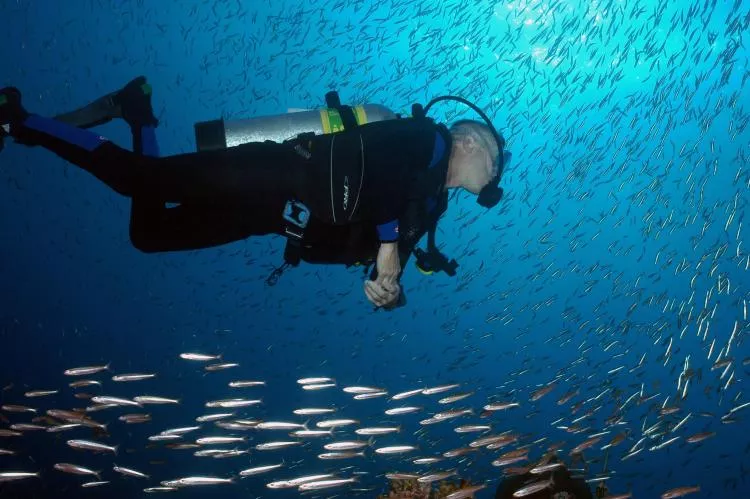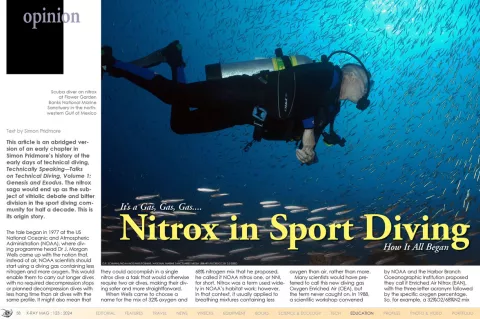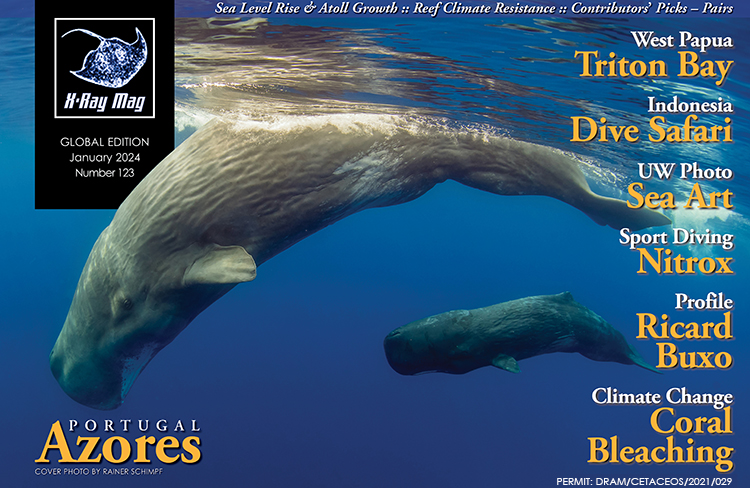This article is an abridged version of an early chapter in Simon Pridmore’s history of the early days of technical diving, Technically Speaking—Talks on Technical Diving, Volume 1: Genesis and Exodus. The nitrox saga would end up as the subject of vitriolic debate and bitter division in the sport diving community for half a decade. This is its origin story.
Contributed by
The tale began in 1977 at the US National Oceanic and Atmospheric Administration (NOAA), where diving programme head Dr J. Morgan Wells came up with the notion that, instead of air, NOAA scientists should start using a diving gas containing less nitrogen and more oxygen. This would enable them to carry out longer dives with no required decompression stops or planned decompression dives with less hang time than air dives with the same profile. It might also mean that they could accomplish in a single nitrox dive a task that would otherwise require two air dives, making their diving safer and more straightforward.
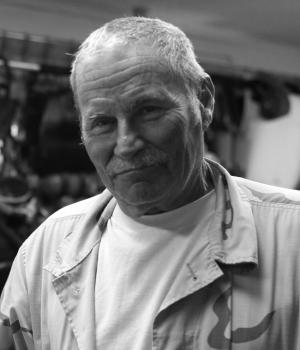
When Wells came to choose a name for the mix of 32% oxygen and 68% nitrogen mix that he proposed, he called it NOAA nitrox one, or NNI, for short. Nitrox was a term used widely in NOAA’s habitat work; however, in that context, it usually applied to breathing mixtures containing less oxygen than air, rather than more.
Many scientists would have preferred to call this new diving gas Oxygen Enriched Air (OEA), but the term never caught on. In 1988, a scientific workshop convened by NOAA and the Harbor Branch Oceanographic Institution proposed they call it Enriched Air Nitrox (EAN), with the three-letter acronym followed by the specific oxygen percentage. So, for example, a 32%O2/68%N2 mix would be referred to as EAN32. That terminology lasted a little longer but, nowadays, everybody calls it nitrox and the other terms have disappeared. Wells may have been alone in his opinion but, nevertheless, it was he who won the day.
Why did Wells choose 32%?
It was just a question of mathematics and his preference for keeping things simple. At that time, the US Navy’s working limit for diving with oxygen or mixed gas was 45 minutes at a pO2 of 1.6. A diver breathing a gas mixture containing 32% oxygen would be breathing a pO2 of 1.6 at 132ft (40m), and 130ft was the maximum depth limit for the NOAA diving programme. So, 32% was a good fit.
Using a concept he called Equivalent Air Depth, Wells created decompression tables for NNI based on the US Navy air tables. This involved comparing the depth at which a nitrox diver would be breathing a certain partial pressure of nitrogen (pN2) with the depth at which an air diver would be breathing the same pN2.
For example, a diver at 80ft (24m) on NNI breathes the same pN2 as an air diver at around 63ft (19m). So, with conservative rounding up, the 70ft (21m) time limits on the US Navy air tables could be applied to 80ft (24m) on the NNI decompression tables. A period of testing using Doppler bubble monitoring suggested that the concept was valid, NNI was approved for use throughout NOAA in 1978 and the new decompression tables were published in the NOAA Diving Manual the following year.
Wells not only won in the naming stakes, but his idea of keeping everything as straightforward as possible has also stood the test of time, certainly as far as standard single-cylinder no-decompression-stop nitrox diving is concerned. As he explained: “I called it NOAA Nitrox I, not referencing the content of the mix because I didn’t want the divers messing around with that. It was all pre-packaged.”
He did not want his diving scientists custom-building their own mixes. Giving NOAA divers a replacement gas for air was not an invitation for them to start experimenting with alternatives. They should just use it, follow the tables, and give no further thought to what gas was in the cylinder than they would if they were diving with air.
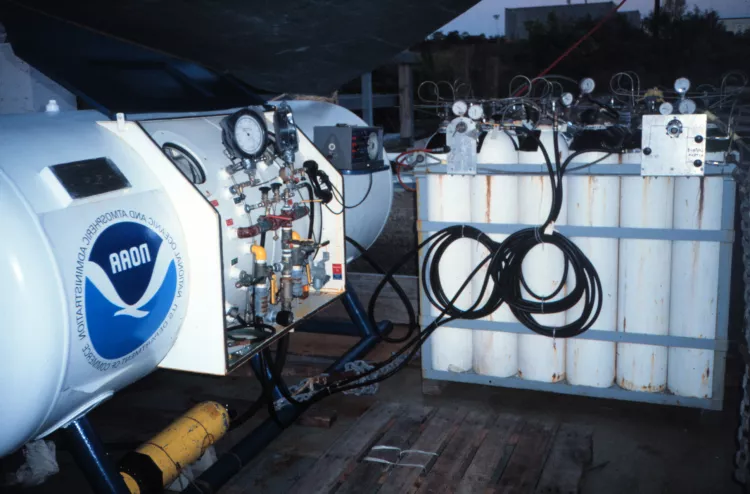
Multiple gasses
In technical diving, we use multiple gasses, we plan which gasses we will use, and we clearly mark our cylinders with the particulars of the mix they contain. In the late 1980s and early 1990s, nitrox diver students were encouraged to do likewise, that is, choose the right nitrox mix for the dive they planned. Most were taking a nitrox diver course as the entry point for technical diving, so introducing technical diving procedures at an early stage made sense.
Tables were developed for a host of different nitrox mixes, from 26% to 40%, and the pile of nitrox cylinders on a dive boat would often include a wide variety of different blends. A contents label attached showing the diver’s initials and the oxygen percentage was, therefore, crucial to avoid getting nitrox cylinders mixed up.
Today, things are very different. Comparatively few divers take a nitrox course as a stepping stone to technical diving. For most people, as for the NOAA divers in the 1970s, nitrox is just an air replacement gas that happens to contain 32% oxygen. To call it nitrox 32 would be tautological. It is just nitrox. There is only one. The cylinder might have a nitrox label, but the idea of a contents label has disappeared in non-technical diving circles.
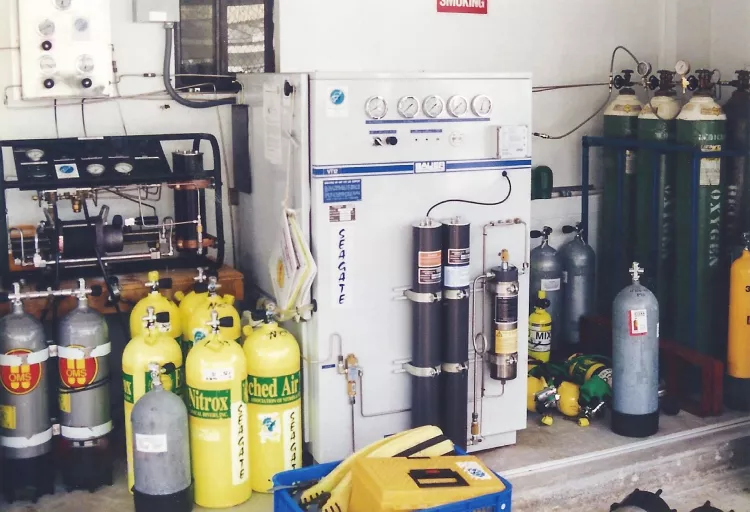
Oxygen percentages
Wells added the Roman numeral I right from the start because he had always intended to introduce a second standard nitrox for shallower diving. Initially, he chose 37.5% oxygen, but by the time he came to publish the tables, he had changed the oxygen percentage to 36%.
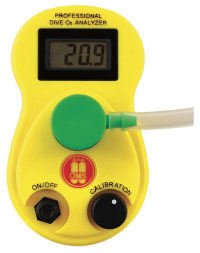
He did this because, according to the Equivalent Air Depth concept, a mix of 37.5% O2/62.5% N2 gave a diver 40 minutes of no-decompression and a pO2 of 1.5 at 100ft (30m). However, although a 40-minute dive was well within the NOAA oxygen exposure limit of 120 minutes at 1.5, Wells worried that if the gas analysis was inaccurate, the oxygen percentage might be slightly higher than intended and a diver’s pO2 might be closer to 1.6 where the oxygen tables allowed a maximum exposure time of only 45 minutes. In this event, a 40-minute no-decompression dive could bring the diver close to the oxygen limits. This made him wary.
“I do not want to give them a chance to really hurt themselves badly through simple errors. Oxygen toxicity is going to get you if you mess around too far out there, and most divers do not even know it exists. All divers know is that you cannot dive deep on air because of nitrogen narcosis. That is probably why there are a bunch of bodies down in some of these caves. They had oxygen hits down there at 250 feet on air.”
Reducing the oxygen percentage from 37.5% to 36% added a useful conservative cushion and made him more comfortable. He called his 36%O2/64%N2 mix NNII, and the new standards first appeared in the 1990 NOAA Diving Manual.
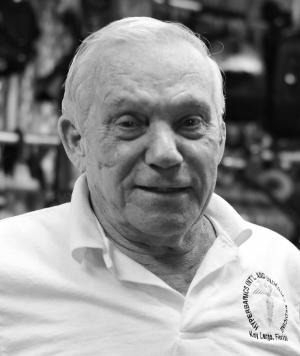
Rutkowski developments
Dick Rutkowski had a long pioneering history with NOAA and worked closely with Wells on the nitrox programmes. In 1985, he retired and started his own company Hyperbarics International, based first in Providenciales in the Turks and Caicos Islands and then in Key Largo, Florida, where he formed the International Association of Nitrox Divers (IAND) to train sport divers to use nitrox.
Rutkowski would use two shipwrecks close to Key Largo for the course dives. They lay on the seabed at 122ft (37m), so they were perfect for demonstrating the advantages of NNI over air. The US Navy tables gave an air diver only 10 minutes of no-deco bottom time for these dives, but the NNI tables granted double that—a full 20 minutes. Allowing two minutes for the descent, an air diver would have eight minutes on site, whereas a diver on NNI would have 18 minutes. This was impressive.
Teaming up
In 1988, Rutkowski teamed up with Ed Betts from Freeport, New York to form American Nitrox Divers Inc. (ANDI). Nitrox was something completely new to sport divers. Over the years, scuba diving for fun in the United States had become strictly defined as using air with open-circuit equipment on dives to a depth no greater than 39m (130ft) and with no required decompression stops. These were not legal limits, they were just conventions, but they were almost universally followed. In other countries, different depth limits were practised, but, in the 1980s, air was the sole diving gas for sport divers everywhere.
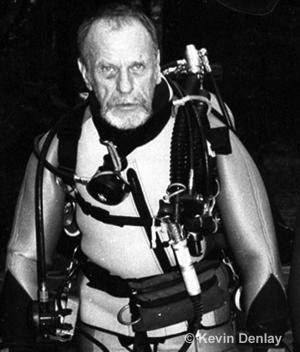
Rutkowski played a major role in changing that, but it was slow going. However, word was out. As Rutkowski revealed at the 1988 Harbor Branch Workshop:
“I just came from the DEMA show and I passed out some literature and mentioned my programme. You should have seen the number of people that told me that they were already using nitrox… we had better take note that they are out there and that they are doing it. They are doing it in a lot of crazy ways. Anything we can do here as part of this programme to ensure proper training to them I think should be brought up.”
These “crazy ways” almost certainly included the dangerous practices of home-brewing and dropping off cylinders partially filled with oxygen at unwitting dive shops to be topped up from regular compressors. Rutkowski’s contribution to “ensure proper training” was to write a formal training manual and in 1989, he finally got around to producing one. The following year, Rutkowski sold IAND to Tom Mount but remained on the company’s Board of Directors, and subsequently, Mount would turn the agency into IANTD, the world’s first technical diver training agency.
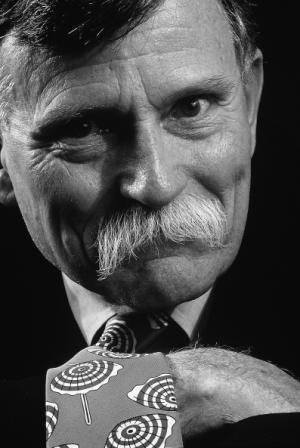
Reception
Speaking in later years about Rutkowski’s nitrox training programme, renowned diving physiologist Dr R.W. “Bill” Hamilton said:
“His course was responsibly delivered (give or take a couple of myths), and popular because it included an interesting dive as part of the deal. For a variety of reasons, perhaps including Rutkowski’s rather aggressive style and the perceived threat to others’ ‘turf,’ the new practice was not well received by the recreational diving community, and an extensive and almost bizarre set of things ‘wrong’ with (nitrox) diving (some correct, some totally wrong) was widely promulgated.”
To say that nitrox was not well-received by the sport diving establishment is an understatement. For many years in the United States, diving’s leading individuals and organisations had conspired to throw an opaque veil over any underwater activity that contradicted the commonly accepted limits—air, open circuit, 39m (130ft), no deco—that defined the activity. Any diving beyond these limits was not sport diving. Sport diving was safe. Diving outside the limits was not safe.
Defending the status quo
Many of the top people in the sport diving world had been (some still were) involved in ultra-deep dives, cave diving and wreck exploration, but, as they were the key policymakers and opinion formers, they felt obliged to defend the status quo and protect dive businesses from anything that might cause insurance companies to withdraw professional coverage or the US government to intervene and regulate the sport.
These were their two major fears, and this is why the idea of single-cylinder nitrox diving generated so much resistance in the early 1990s. It was seen as a threat to the survival of the sport as a recreational activity.
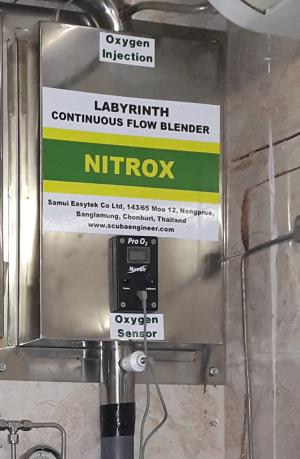
They claimed that:
• Its main advocates were untrustworthy.
• Nitrox could not be produced safely by divers or dive operators.
• Nitrox was incompatible with standard scuba gear.
• Nitrox marketing included lies and exaggerations.
• The nitrox advocates’ statement that “nitrox is safe, air is dangerous” made sport diving sound risky.
Nitrox was at the thin end of a technical diving wedge that would end up breaching all of sport diving’s established limits. If the “air only” domino was toppled, the rest would follow.
So, the self-proclaimed guardians of sport diving took aim at nitrox and opened fire. Thus began the uncivil war that would consume much of the energy of the diving world for the next five years. ■

